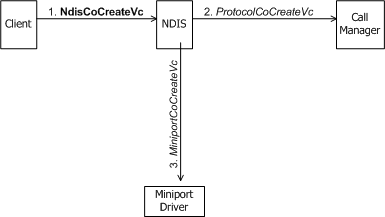Creating a VC
Before making an outgoing call, a connection-oriented client initiates the creation a virtual connection (VC). Before indicating an incoming call to a connection-oriented client, a call manager or an MCM driver initiates the creation of a VC . After the VC has been set up and activated, client data can be transmitted or received on the VC.
A call manager or an MCM driver can also initiate the creation of a VC on which signaling messages are exchanged with network components, such as a network switch.
Client-Initiated Creation of a VC
Before making a call with NdisClMakeCall, a connection-oriented client calls NdisCoCreateVc to initiate the creation of a VC.
The following figure shows a client of a call manager initiating the creation of a VC.

The following figure shows a client of an MCM driver initiating the creation of a VC.

When a connection-oriented client of a call manager calls NdisCoCreateVc, NDIS calls, as a synchronous operation, the ProtocolCoCreateVc function of the call manager and the MiniportCoCreateVc function of the underlying miniport driver (see the first figure in this topic). NDIS passes an NdisVcHandle that represents the VC to both ProtocolCoCreateVc and MiniportCoCreateVc. If the call to NdisCoCreateVc is successful, NDIS returns the NdisVcHandle to NdisCoCreateVc.
ProtocolCoCreateVc allocates and initializes any dynamic resources and structures that the call manager requires to perform subsequent operations on a VC that will be activated. MiniportCoCreateVc allocates and initializes any resources that the miniport driver requires to maintain state information about the VC. Both ProtocolCoCreateVc and MiniportCoCreateVc store the NdisVcHandle .
When a connection-oriented client of an MCM driver, the call to NdisCoCreateVc causes NDIS to call the MCM driver's ProtocolCoCreateVc function (see Client-Initiated Creation of a VC (MCM Driver Present)). In this case, ProtocolCoCreateVc performs the necessary allocation and initialization of resources for the VC. There is no call (internal or otherwise) to MiniportCoCreateVc, because an MCM driver does not supply such a function.
Call Manager-Initiated Creation of a VC
Before indicating an incoming call to a connection-oriented client with NdisCmDispatchIncomingCall, a call manager calls NdisCoCreateVc to initiate the creation of a VC (see the following figure).

When a call manager calls NdisCoCreateVc, NDIS calls, as a synchronous operation, the ProtocolCoCreateVc function of the connection-oriented client that registered the SAP on which the call is being received, as well as the MiniportCoCreateVc function of the underlying miniport. NDIS passes an NdisVcHandle that represents the VC to both ProtocolCoCreateVc and MiniportCoCreateVc. If the call to NdisCoCreateVc is successful, NDIS returns the NdisVcHandle to NdisCoCreateVc.
MCM Driver-Initiated Creation of a VC
Before indicating an incoming call to a connection-oriented client with NdisMCmDispatchIncomingCall, an MCM driver calls NdisMCmCreateVc to initiate the creation of a VC (see the following figure).

When an MCM driver calls NdisMCmCreateVc, NDIS calls, as a synchronous operation before NdisMCmCreateVc returns, the ProtocolCoCreateVc function of the connection-oriented client that registered the SAP on which the call is being received. NDIS passes an NdisVcHandle that represents the VC to ProtocolCoCreateVc. If the call to NdisMCmCreateVc is successful, NDIS returns the NdisVcHandle to NdisMCmCreateVc.
ProtocolCoCreateVc allocates and initializes any dynamic resources and structures that the client requires to perform subsequent operations on the VC. ProtocolCoCreateVc also stores the NdisVcHandle .
Note that when an MCM driver creates a VC for exchanging signaling messages with a network component, it does not use NdisXxx calls to create a VC. In fact, an MCM driver does not use NdisXxx calls to create, activate, deactivate, or delete such VCs. Instead, an MCM driver performs these operations internally. Such VCs are therefore opaque to NDIS.